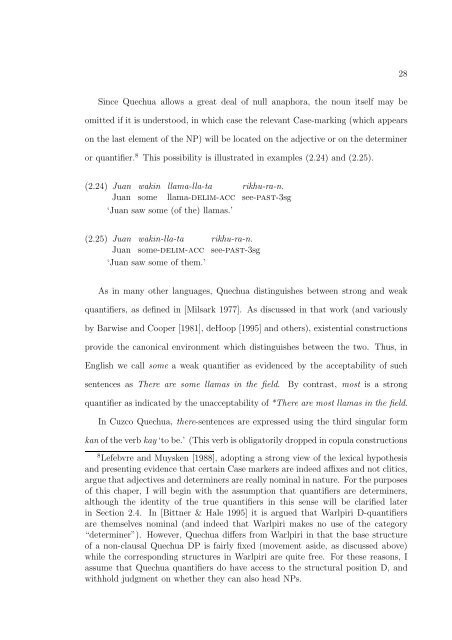the syntax and semantics of relativization and quantification
the syntax and semantics of relativization and quantification
the syntax and semantics of relativization and quantification
You also want an ePaper? Increase the reach of your titles
YUMPU automatically turns print PDFs into web optimized ePapers that Google loves.
28<br />
Since Quechua allows a great deal <strong>of</strong> null anaphora, <strong>the</strong> noun itself may be<br />
omitted if it is understood, in which case <strong>the</strong> relevant Case-marking (which appears<br />
on <strong>the</strong> last element <strong>of</strong> <strong>the</strong> NP) will be located on <strong>the</strong> adjective or on <strong>the</strong> determiner<br />
or quantifier. 8 This possibility is illustrated in examples (2.24) <strong>and</strong> (2.25).<br />
(2.24) Juan<br />
Juan<br />
wakin<br />
some<br />
llama-lla-ta<br />
llama-delim-acc<br />
‘Juan saw some (<strong>of</strong> <strong>the</strong>) llamas.’<br />
rikhu-ra-n.<br />
see-past-3sg<br />
(2.25) Juan wakin-lla-ta<br />
Juan some-delim-acc<br />
‘Juan saw some <strong>of</strong> <strong>the</strong>m.’<br />
rikhu-ra-n.<br />
see-past-3sg<br />
As in many o<strong>the</strong>r languages, Quechua distinguishes between strong <strong>and</strong> weak<br />
quantifiers, as defined in [Milsark 1977]. As discussed in that work (<strong>and</strong> variously<br />
by Barwise <strong>and</strong> Cooper [1981], deHoop [1995] <strong>and</strong> o<strong>the</strong>rs), existential constructions<br />
provide <strong>the</strong> canonical environment which distinguishes between <strong>the</strong> two. Thus, in<br />
English we call some a weak quantifier as evidenced by <strong>the</strong> acceptability <strong>of</strong> such<br />
sentences as There are some llamas in <strong>the</strong> field. By contrast, most is a strong<br />
quantifier as indicated by <strong>the</strong> unacceptability <strong>of</strong> *There are most llamas in <strong>the</strong> field.<br />
In Cuzco Quechua, <strong>the</strong>re-sentences are expressed using <strong>the</strong> third singular form<br />
kan <strong>of</strong> <strong>the</strong> verb kay ‘to be.’ (This verb is obligatorily dropped in copula constructions<br />
8 Lefebvre <strong>and</strong> Muysken [1988], adopting a strong view <strong>of</strong> <strong>the</strong> lexical hypo<strong>the</strong>sis<br />
<strong>and</strong> presenting evidence that certain Case markers are indeed affixes <strong>and</strong> not clitics,<br />
argue that adjectives <strong>and</strong> determiners are really nominal in nature. For <strong>the</strong> purposes<br />
<strong>of</strong> this chaper, I will begin with <strong>the</strong> assumption that quantifiers are determiners,<br />
although <strong>the</strong> identity <strong>of</strong> <strong>the</strong> true quantifiers in this sense will be clarified later<br />
in Section 2.4. In [Bittner & Hale 1995] it is argued that Warlpiri D-quantifiers<br />
are <strong>the</strong>mselves nominal (<strong>and</strong> indeed that Warlpiri makes no use <strong>of</strong> <strong>the</strong> category<br />
“determiner”). However, Quechua differs from Warlpiri in that <strong>the</strong> base structure<br />
<strong>of</strong> a non-clausal Quechua DP is fairly fixed (movement aside, as discussed above)<br />
while <strong>the</strong> corresponding structures in Warlpiri are quite free. For <strong>the</strong>se reasons, I<br />
assume that Quechua quantifiers do have access to <strong>the</strong> structural position D, <strong>and</strong><br />
withhold judgment on whe<strong>the</strong>r <strong>the</strong>y can also head NPs.
















